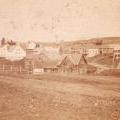 Although Massawippi is by no means a ghost town, the village is a long way from the vibrant little community it once was. Situated at the junction of Routes 208 and 143, about midway between Stanstead and Lennoxville, the village’s origins date back to the beginning of the 1800s.
Although Massawippi is by no means a ghost town, the village is a long way from the vibrant little community it once was. Situated at the junction of Routes 208 and 143, about midway between Stanstead and Lennoxville, the village’s origins date back to the beginning of the 1800s.
Like many pioneer settlements in the Eastern Townships, Massawippi owes its location to the presence of a waterfall. After the road was laid out through Hatley Township, north of Boroughs Falls, in the early 1800s, mills were built on the Brook at the site of the future village. These mills, altered and sold several times over the years, would form the heart of the village for several generations to come.
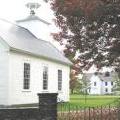 According to Townships historian Benjamin Hubbard, who wrote Forests and Clearings in 1874, Appleton Plumley built the first saw mill in Massawippi, while Daniel Bacon built a grist mill soon after. Another settler, Stephen Burbank, bought these mills and built a distillery. This distillery was followed by other distilleries and, wrote Hubbard, “the evils entailed upon the community by these nuisances were long severely felt. Through the confirmed influence of strong drink, many of the early settlers sunk to the most abject poverty, and were compelled to sell out and leave the country.”
According to Townships historian Benjamin Hubbard, who wrote Forests and Clearings in 1874, Appleton Plumley built the first saw mill in Massawippi, while Daniel Bacon built a grist mill soon after. Another settler, Stephen Burbank, bought these mills and built a distillery. This distillery was followed by other distilleries and, wrote Hubbard, “the evils entailed upon the community by these nuisances were long severely felt. Through the confirmed influence of strong drink, many of the early settlers sunk to the most abject poverty, and were compelled to sell out and leave the country.”
In 1842, Samuel Harvey, of Compton, purchased the Burbank mills and erected new mills in the village. This was a new start for the village, for in that same year, “a clothier’s shop, a blacksmith shop, and a shoemaker’s shop were started, and a full store of goods was opened by Knight & Demick.” The following year, wrote Hubbard, “a tannery and three or four new dwelling houses were built. Since that time, the village has gradually increased in number of buildings and wealth. It now (1874) contains one church, one tavern, two stores, one tannery, a grist mill, a sawmill, a post office, two cabinet and wheelwright shops, two blacksmith shops, a tailor’s shop and grocery, a harness shop, a boot and shoe shop, and about 40 dwelling houses, and numbers about 175 inhabitants.”
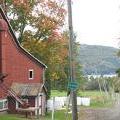 The Belden Atlas, published in 1881, added that Massawippi was a “prettily situated village, east of the lake,” containing “mills, tannery, a building for municipal meetings and school, and a Union church in which Episcopal, Presbyterian, Methodist, Universalist, and Baptist services are held each Sunday. […] The railway station is about a mile from the village, on the lake shore.”
The Belden Atlas, published in 1881, added that Massawippi was a “prettily situated village, east of the lake,” containing “mills, tannery, a building for municipal meetings and school, and a Union church in which Episcopal, Presbyterian, Methodist, Universalist, and Baptist services are held each Sunday. […] The railway station is about a mile from the village, on the lake shore.”
Despite the rosy descriptions at the end of the nineteenth century, the twentieth century would not be a prosperous one for Massawippi. The population declined, with many of the families moving to larger centres, and most of the businesses and community life disappearing altogether.
Some lovely early homes, however, did manage to survive the ravages of time and changes in local economies – not to mention the pressures associated with having a modern highway (and truck route) barrel right through the village.
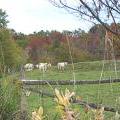 A number of old homes still line Route 143, which unfortunately now serves – inescapably – as the village’s main thoroughfare. Yet despite the high volume of traffic that passes by these homes, often at excessive speeds, and despite the village’s location at a bend and dip in the road, the village has somehow retained its aura of yesteryear. Indeed, apart from the cars and trucks that speed by, and the obvious dearth of commercial activity, there are few signs that change has actually occurred in Massawippi.
A number of old homes still line Route 143, which unfortunately now serves – inescapably – as the village’s main thoroughfare. Yet despite the high volume of traffic that passes by these homes, often at excessive speeds, and despite the village’s location at a bend and dip in the road, the village has somehow retained its aura of yesteryear. Indeed, apart from the cars and trucks that speed by, and the obvious dearth of commercial activity, there are few signs that change has actually occurred in Massawippi.
The village’s other main thoroughfare is Route 208, which leads west from the 143 to Ayer’s Cliff and Lake Massawippi. This road is lined with trees and some fine old homes. The Union Church, built in the New England style in 1861, stands to this day as a reminder of the village’s American roots. Though it is now seldom used, the church is still occasionally opened for services and other community events.
Adjacent to the Union Church is the sprawling Massawippi Cemetery. Among the towering hardwoods that shade this old burial ground are the final resting places of Lothrop Shurtleff (1798-1862), Otis Chilson (1800-1871), and many of the area’s other early pioneers.
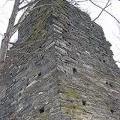 Across the road from the cemetery is the old village schoolhouse, a large two-storey clapboard building used only occasionally now as a public meeting hall. Here Massawippi seems especially timeless.
Across the road from the cemetery is the old village schoolhouse, a large two-storey clapboard building used only occasionally now as a public meeting hall. Here Massawippi seems especially timeless.
Back on the 143, a modern municipal hall was built in Massawippi a few years ago. The style of building reflects the architecture of the other buildings in the vicinity, so the hall blends in with its surroundings. Within a stone’s throw of the new hall is what is certainly one of Massawippi’s oldest structures – the mill.
Sadly a ruin now, the mill is still nevertheless an impressive sight. Its towering walls of black stone are just visible from Route 143, from the modern bridge over the Brook. If a driver were not aware of its existence, he would probably never know the mill was even there. This splendid ruin, which is over a century and a half old, awaits restoration and, perhaps, new life. Much like the rest of Massawippi Village, it seems to have gone to sleep, oblivious to the cars speeding by. Whether new life or further decay takes hold, only time will tell.